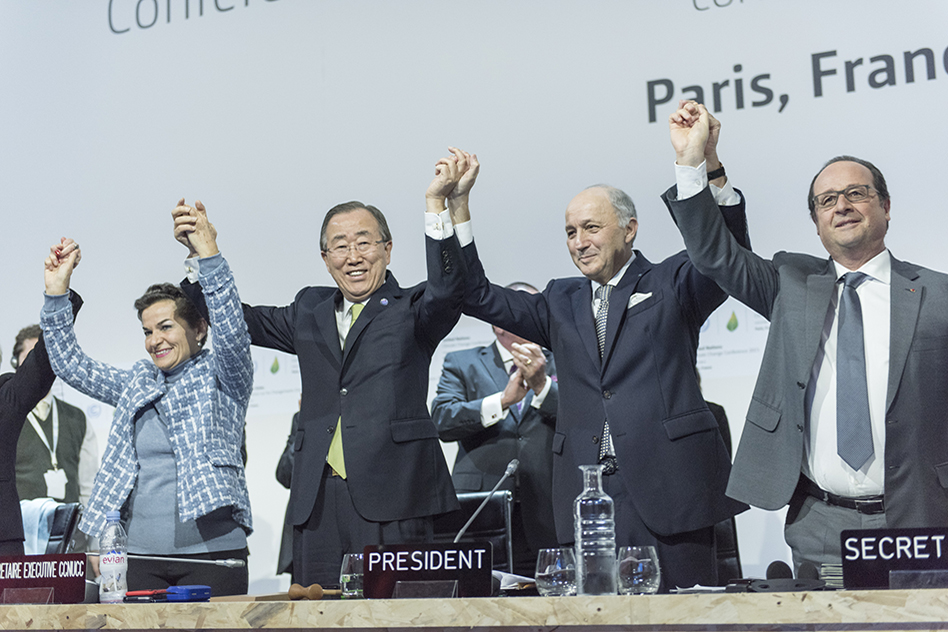
Under the Paris Agreement on climate change, each of nearly 200 countries has defined its own contribution to reducing global greenhouse gas (GHG) emissions based on local interests, politics and economics. These pledges, known as Nationally Determined Contributions (INDCs), represent a first step in getting the world on track to limit Earth’s average global surface temperature to two degrees Celsius above pre-industrial levels—a threshold identified by the United Nations Framework Convention on Climate Change (UNFCCC) as necessary to avoid the most serious impacts of climate change. Toward that end, the agreement includes guidelines for review of national pledges designed to ensure that NDCs are not only implemented but strengthened over time.
The question is, is this review process up to the task of achieving the 2° C goal?
With that goal in mind, the Agreement stipulates that every five years, signatories will participate in a transparency framework to monitor, review and verify implementation of current national pledges, and encourage increasing ambition going forward. An important challenge in implementing the framework is to establish common procedures to measure compliance with complex emissions reduction targets, and assess overall progress in meeting global climate goals. Successful implementation will also depend on the signatories having access to clear, reliable and comparable measures of national effort—information that can help develop the trust and expectation of reciprocity that will be needed to bolster national decisions to increase ambition in the future.
“Transparency is crucial to the success of a pledge-and-review system like Paris,” says MIT Sloan School of Management Professor Emeritus Henry (Jake) D. Jacoby, whose research centers on the economic analysis of climate change and GHG mitigation. “And it is particularly important at early stages of the launch of this Agreement, when details of review guidelines are still being negotiated. Policymakers and the public need to see rigorous analysis of participating nations’ performance so they can understand how well the first stages are working to lower emissions and form a view of whether the behavior of these nations is fair.”
Jacoby, who co-founded the MIT Joint Program on the Science and Policy of Global Change, explores ground rules for this analysis in a new study in the journal Climate Policy. His co-authors are Joint Program research scientist Y.-H. Henry Chen and Brian P. Flannery, a Center Fellow at Resources for the Future.
The researchers argue that until outputs of the formal transparency framework are available, the pledge-and-review process will need to rely on academic and other non-governmental organizations to provide timely analyses. Using the MIT Economic Projection and Policy Analysis (EPPA) model to construct sample analyses, they explore how economic modeling conducted outside official channels can support three aspects of a transparent implementation of the Paris Agreement: credibility (providing a reliable means of defining and evaluating performance on national GHG mitigation pledges); effectiveness (providing reliable and accurate assessments of progress in achieving intended national and aggregate global emissions goals); and fairness (providing reliable and accurate comparisons of national mitigation efforts).
This level of transparency will be needed to support decision-makers as they determine whether to renew or intensify pledges every five years, but achieving it will not be easy.
First, the format of national climate pledges varies widely, making it difficult to track global progress and evaluate the relative effort of participating nations. For example, some countries commit to reduce carbon dioxide emissions by a certain target value relative to a business-as-usual projection, while others pledge to reduce their emissions intensity (e.g., tons per dollar of GDP) below a base year by a future year. Second, institutions use different data to measure how nations are progressing on their climate pledges, and apply different methods to analyze those data. Studies are often inconsistent and/or unclear when it comes to projections of business-as-usual emissions and GDP, assumptions about pledges that are contingent on financial aid, and assumed performance.
To overcome such challenges, the co-authors recommend that researchers at these institutions develop standards of practice and documentation for measuring NDCs, evaluating and reporting national progress in their fulfillment, comparing relative national effort, and assessing global progress.
“Modeling groups need to be clearer on what they’re doing,” says Jacoby. “Transparency, clarity and credibility are very important in a system where people are making voluntary pledges, and need to know if the agreement is working and if it’s fair.”
Getting transparency right is especially crucial in the first phase of the Paris Agreement. Ensuring that all parties have credible information on national progress and relative national economic burden in achieving climate goals will be critical to motivating each participating nation to meet its first NDC and intensify its commitment in future cycles.
Photo: Closing Ceremony of COP21, Paris, 2015. A high level of transparency will be needed to support decision-makers responsible for renewing and intensifying national pledges every five years. (Source: United Nations Photo)

